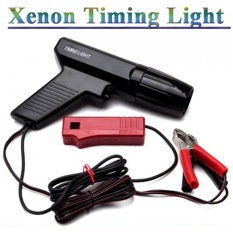Blog
Who needs a timing light?

When your car engine suddenly starts to thump and shudder, you are naturally concerned and do not feel very confident. This is commonly known as knocking and it could be the result of the engine's timing being a little off or it could also mean something more serious. At moments such as this, you have only two choices – take your car to your local auto repair shop or take it home and diagnose it yourself.
Your local auto repair shop will likely charge you for telling you exactly what is wrong with your car during the estimate process and he will charge you for fixing it up. However, if your car is not the latest type with computerized controls, you could probably save some money by diagnosing the problem on your own. If your car has a distributor, using a timing light is enough to let you know what is wrong with the car.
In general, cars have spark plugs that ignite the fuel in the engine, generating energy for driving the car. However, spark plugs must fire at the right time and in the proper sequence for the engine to operate at peak power and efficiency. A timing light helps to find out if the sequence and timing of the firing is correct and if not, helps to fine-tune it.
What Is A Timing Light?
There are various types of timing lights available in different shapes and sizes. These features range from bare-bones functionality to a plethora of bells and whistles. While the smallest and the least expensive timing light fits into the simple shape of a pen, people generally prefer a timing light that is in the shape of a ray gun. The pistol grip type is more ergonomic to hold inside the close confines of a car's engine. However, if you prefer one that is easier to read in bright conditions, it will likely be more expensive.
Timing lights are different from normal flashlights because they do not require separate batteries to power them up and you do not need to worry about them running out of juice. As long as you have a working car battery, the timing light will also function.
How Do You Connect A Timing Light?
Connecting a timing light is very simple. First, you must switch off the engine of your car. Next, locate the RED wire of the timing light and clamp it to the positive terminal of the battery. Then, locate the BLACK wire of the timing light and clamp it to the negative terminal of the battery. Lastly, connect the signal wire of the timing light and clamp it to the directly to the wire of spark plug number 1. Look up the service manual or the owner's manual for your vehicle in case you are not sure of which of the spark plugs is the first one.
Some of the older type of timing lights needs the signal wire to be connected directly to the tip of the spark plug. However, most of the currently available light units work with their signal wire clipped right on the spark plug wire itself. The inductive nature of the timing lights allow them to detect when the spark plug fires by detecting the jolt of electricity on the plug. Therefore, as you pull the trigger of the timing light with the engine running, each time the spark plug Number 1 fires you see a flashing beam from the timing light.
How Does the Timing Light Work?
The timing light uses the stroboscopic effect for working. If you aim the timing light properly, as the spark fires, it will light up to indicate the position the Number 1 piston is in as it travels up and down. Actually, you will not be seeing the location of the piston. Since the timing of the spark is measured in degrees, you will rather see how far the crankshaft has rotated relative to the Number 1 piston at the TDC or top dead center of the compression stroke.
The crankshaft pulley on some vehicles is marked in degrees and numbers. The engine will also have a mark right next to the pulley for representing TDC. Because of the stroboscopic effect, the timing light 'freezes' the motion of the pulley. This allows you to see if the spark is firing before or after the TDC and by how many degrees.
You can manipulate the distribution cap, turning it slightly clockwise or anti-clockwise to adjust the timing of delivery of the sparks. Some manufacturers make things more confusing by placing the timing marks on the flywheel or even on the pulley of the fan. Some also mark the indications in reverse, so you must refer to the user manual of your vehicle to know what you must do to set the sparks right.
How To Know What The Proper Timing Specifications Are?
If you look under the hood of your car or along its fender well, you will come across the Vehicle Emission Control Information Label, which should contain this timing specification. Alternately, the service manual specific to your vehicle should also report it.
However, a person may wish to keep the timings such that the spark fires earlier than the piston reaches the TDC, which means the timing is now advanced. However, if the vehicle is experiencing excessive knocking, it is a better idea to retard the timing, that is, to have the spark ignite the fuel a little after the piston reaches the TDC.
overall rating:
my rating:
log in to rate

